8D BIM Model in Urban Rehabilitation Projects: Enhanced Occupational Safety for Temporary Construction Works
Abstract
Featured Application
Abstract
1. Introduction
2. 8D BIM Concept and Application
2.1. Parametric Modeling
2.2. Interoperability
2.3. BIM Dimensions
- The 3D BIM model represents the set of 3D parametric objects used in all project disciplines (architecture, structures, and systems);
- The 4D BIM model is concerned with the simulation of the building’s construction work, planned according to the established critical path network [28];
- The 5D BIM model supports the prediction of the construction costs based on the quantity take-off of the applied materials [29];
- The 6D BIM model concerns the energy and sustainability studies and simulation in the project phase and in the occupation stage;
- The 7D BIM model deals with the management and maintenance of the building throughout its period of use;
- The 8D BIM model encompasses aspects related to human safety in construction, supporting preventive care actions such as risk detection in construction.
2.4. Occupation Safety and Health in Construction Projects
3. Empirical Case Study: Full Building Renovation with Preservation of Façade
4. Modeling of Physical Elements (3D BIM)
4.1. Modeling of the Façade to Be Preserved and the New Elements to Be Built
4.2. Modeling the Context of the Construction Site
4.3. Model of the Temporary Steel Structural System
4.3.1. Modeling the Components
4.3.2. Assembling the Temporary Support System
4.4. Modeling of the Tower Crane
5. Modeling of the Construction Works (4D BIM)
5.1. Construction Site Constraints and Preparatory Activities
- Removal of the roof—The roof tiles contained asbestos, which is a very hazardous material to the health of workers in the building, meaning that this activity took precedence above the others;
- Implementation of the tower crane—This process was accomplished with the assistance of an additional mobile crane and demanded temporary shafts to be created inside the building (Figure 14);
- Temporary support of façade and scaffolding—Due to a lack of space in the public street, the support system for the façade walls was implemented inside the building and in the backyard (Figure 11 and Figure 12) with the aid of the tower crane (Figure 13). The modeling allowed for early identification of clashes with temporary scaffolding and enabled the early preparation of alternatives to be considered (Figure 15);
- Demolition—In the interior part of the building, some of the walls were first demolished. Due to the age of the building, and the traditional materials applied, intensive manual labor was involved in the demolition work. Once the support system was fully positioned over the façade walls, the demolition process started from top to bottom. However, the positioning of the façade system required the demolition of the interior walls of floors −1, 1, and 3;
- Construction works—Once the interior of the building was fully demolished, with only the façade walls remaining, the construction works begun, progressing from bottom to top and starting at the −2 floor;
- Removal of the support system—The removal was executed in a phased way, occurring in tandem with the construction works.
5.2. Hazards and Occupational Safety
- Fall from height;
- Exposure to chemical and biological hazards;
- Crushing and other hazards exposure in the assembly and/or removal of structural elements (e.g., façade support system).
- Implementation of guardrails where falls can eventually occur with a high possibility;
- Protection of floor openings (Figure 14);
- Correct use of ladders, as these must be properly fixed and be in good conditions.
- The permanent protection devices must always be used when a worker is at the construction site (e.g., helmet, steel toe boots, vests, and gloves);
- The temporary protection equipment is used when manipulating specific materials or machinery (e.g., goggles, earplugs, and masks).
6. Modeling of Occupational Safety Coordination in Construction (8D BIM)
6.1. Clash Detection
- Belonging to the architecture model;
- Belonging to the temporary support system of the façade walls;
- Belonging to other temporary elements in the construction site.
- The inconsistencies that can be resolved and approved by the Navisworks user (such as expected conflicts as the placement of the steel beam that secures the support system to the façade walls, or small geometric imprecisions that occurred during the modeling);
- The collisions that require being remodeled in Revit, and after a new test must be applied.
6.2. Safety Prevention
- The first performed simulation concerns the accesses to the construction site. There are two possible entrances, a front entrance and a small adjacent one on the side of the building. The front entrance is located on a narrow street with a very small sidewalk, and to prevent the fall of an object, an upper barrier integrated with the scaffolding was proposed (Figure 17);
- Additionally, there is a possibility of accidents occurring due to the fall of objects onto the sidewalk. For this purpose, scaffolding with safety guards was placed above the sidewalks (Figure 18);
- The side entrance also demonstrates the lack of space and requires a barrier in order to limit access to the site. For this purpose, a door was placed (Figure 19).



- In relation to the interior of the construction, the structure of the containment system occupies a large amount of space inside each floor, significantly conditioning the work resulting in the area. An avatar moving inside the place illustrates the worker’s difficulties in operating inside the building (Figure 23).
6.3. Planning and Sequencing Activities
6.4. Construction Simulation
7. Conclusions
- Operating Revit software, a precise and detailed 3D model of the project was built, and this was accomplished by using existing objects in the Revit library and through the family creation system;
- A clash detection text was performed; some existing conflicts were resolved by using the Navisworks software and the others that needed to be remodeled were in Revit;
- The scheduling plan of the construction project was performed swiftly and efficiently with the support of MS Project. Once the conflicts were resolved, several simulations of the construction site and its activities were conducted;
- Through the visual simulation performed in the system by the insertion of an avatar walking inside, several situations of eventual hazards were identified. Adequate solutions were then proposed, namely in the entrances to the construction site or a worker moving inside the still frame. There were several identified constraints and hazards associated with them, and safety measures were proposed accordingly.
Supplementary Materials
Author Contributions
Funding
Institutional Review Board Statement
Informed Consent Statement
Data Availability Statement
Conflicts of Interest
References
- Barbosa, F.; Woetzel, J.; Mischke, J.; Ribeirinho, M.J.; Matthew, S.; Bertram, N.; Brown, S. Reinventing Construction: A Route to Higher Productivity; McKinsey & Company, Chicago, USA: 2017. Available online: https://www.mckinsey.com/business-functions/operations/our-insights/reinventing-construction-through-a-productivity-revolution (accessed on 5 September 2022).
- Couto, J.P.; Teixeira, J.M.C. The consequences of non-compliance with deadlines for the competitiveness of the construction industry-reasons for delays. In Proceedings of the 3rd Conference in Enginnering, Covilha, Portugal, 5–8 December 2005; Available online: https://hdl.handle.net/1822/5068 (accessed on 1 September 2022).
- Klein, H.C.; Stelter, A.; Oschinsky, F.M.; Niehaves, B. A status quo bias perspective on user resistance in building information modeling adoption–Towards a taxonomy. Comput. Ind. 2022, 143, 103760. [Google Scholar] [CrossRef]
- Zhao, Y.; Taib, N. Cloud-based Building Information Modelling (Cloud-BIM): Systematic literature review and Bibliometric-qualitative Analysis. Autom. Constr. 2022, 142, 104468. [Google Scholar] [CrossRef]
- Zheng, X.; Lu, Y.; Li, Y.; Le, Y.; Xiao, J. Quantifying and visualizing value exchanges in building information modelling (BIM) projects. Autom. Constr. 2019, 99, 91–108. [Google Scholar] [CrossRef]
- Deng, M.; Wang, X.; Li, D.; Menassa, C.C. Digital ID framework for human-centric monitoring and control of smart buildings. Build. Simul. 2022, 15, 1709–1728. [Google Scholar] [CrossRef]
- Setaki, F.; Timmeren, A. Disruptive technologies for a circular building industry. Build. Environ. 2022, 223, 103394. [Google Scholar] [CrossRef]
- Wang, W.; Guo, H.; Li, X.; Tang, S.; Li, Y.; Xie, L.; Lv, Z. BIM Information Integration Based VR Modeling in Digital Twins in Industry 5.0. J. Ind. Inf. Integr. 2022, 28, 100351. [Google Scholar] [CrossRef]
- Tran, S.V.-T.; Nguyen, T.L.; Chi, H.-L.; Lee, D.; Park, C. Generative planning for construction safety surveillance camera installation in 4D BIM environment. Autom. Constr. 2022, 134, 104103. [Google Scholar] [CrossRef]
- Akbal, E.; Tuncer, T. A learning model for automated construction site monitoring using ambient sounds. Autom. Constr. 2022, 134, 104094. [Google Scholar] [CrossRef]
- Sousa, H.; Sguazzo, C.; Cabaleiro, M. Use of BIM in rehabilitation and assessment of the built heritage, In Proceedings of the IABSE Symposium 2019 Guimarães: Towards a Resilient Built Environment-Risk and Asset Management, Guimarães, Portugal, 27–29 March 2019. [CrossRef]
- Bacci, G.; Bertolini, F.; Bevilacqua, M.G.; Caroti, G.; Martínez-Espejo, I.; Martino, M.; Piemonte, A. HBIM methodologies for the architectural restoration. The case of the ex-church of San Quirico All’olivo in Lucca, Tuscany. Int. Arch. Photogramm. Remote Sens. Spatial Inf. Sci. 2019, XLII-2/W11, 121–126. [Google Scholar] [CrossRef]
- Cuartero, J.; Cabaleiro, M.; Sousa, H.S.; Branco, J.M. Tri-dimensional parametric model for prediction of structural safety of existing timber roofs using laser scanner and drilling resistance tests. Eng. Struct. 2019, 185, 58–67. [Google Scholar] [CrossRef]
- García-Valldecabres, J.; Galiano-Garrigós, A.; Meseguer, L.C.; López-González, M.C. HBIM work methodology applied to preventive maintenance: A state-of-the-art review. In Building Information Modelling (BIM) in Design, Construction and Operations IV; WIT Transactions on The Built Environment; WIT Press: Santiago de Compostela, Spain, 2021; Volume 205, Available online: https://www.witpress.com/elibrary/wit-transactions-on-the-built-environment/205/38170 (accessed on 1 September 2022).
- Manjia, M.B.; Merveilles, U.J.; Pettang, N.; Ouambo, P.; Fandjio, C.C.; Abanda, F.H.; Pettang, C. Integration and impact of BIM in the rehabilitation of buildings in developing countries. J. Decis. Syst. 2022, 1. [Google Scholar] [CrossRef]
- Sola-Caraballo, J.; Rincón-Calderón, J.M.; Rivera-Gómez, C.; López-Martínez, J.A.; Galán-Marín, C. On-Site Risk Assessment Methodology of Historic Timber Structures: The Case Study of Santa Cruz Church. Buildings 2022, 12, 935. [Google Scholar] [CrossRef]
- Vidovszky, I. Impact-based Diagnostic Approach for Maintenance Monitoring of Historic Buildings. Procedia Eng. 2016, 164, 575–582. [Google Scholar] [CrossRef]
- Moyano, J.; Gil-Arizón, I.; Nieto-Julián, J.E.; Marín-García, D. Analysis and management of structural deformations through parametric models and HBIM workflow in architectural heritage. J. Build. Eng. 2022, 45, 103274. [Google Scholar] [CrossRef]
- Croce, P.; Landi, F.; Puccini, B.; Martino, M.; Maneo, A. Parametric HBIM Procedure for the Structural Evaluation of Heritage Masonry Buildings. Buildings 2022, 12, 194. [Google Scholar] [CrossRef]
- Croce, V.; Caroti, G.; De Luca, L.; Jacquot, K.; Piemonte, A.; Véron, P. From the Semantic Point Cloud to Heritage-Building Information Modeling: A Semiautomatic Approach Exploiting Machine Learning. Remote Sens. 2021, 13, 461. [Google Scholar] [CrossRef]
- Gilmour, L.; Stroulia, E. Ortho-photogrammetry for prefabricated energy-efficiency retrofits. Autom. Constr. 2022, 134, 104082. [Google Scholar] [CrossRef]
- Sacks, R.; Eastman, C.M.; Teicholz, P.; Lee, G. BIM Handbook: A Guide to Building Information Modeling for Owners, Designers, Engineers, Contractors, and Facility Managers, 3rd ed.; John Wiley & Sons, Inc.: Hoboken, NJ, USA, 2018; p. 688. ISBN 978-1-119-28755. [Google Scholar]
- Eastman, C. An outline of the building description system. Institute of Physical Planning, Carnegie-Mellon University Pittsburgh, USA, Pa. Inst. of Physical Planning. Research Report No. 50. September 1974, Computer Science, 23pgs. Available online: https://files.eric.ed.gov/fulltext/ED113833.pdf (accessed on 5 September 2022).
- Sampaio, A.Z.; Gomes, A.M. Professional one-day training course in BIM: A practice overview of multi-applicability in Construction. J. Softw. Eng. Appl. 2022, 15, 131–149. [Google Scholar] [CrossRef]
- Constantino, G.B. BIM 8D Model: Application for Temporary Support System of Facades. Master’s Thesis, Department of Civil Engineering, University of Lisbon, Lisbon, Portugal, 2021. [Google Scholar]
- Nederveen, G.A.; Tolman, F.P. Modelling multiple views on buildings, Automation in Construction. ScienceDirect 1992, 1, 215–224. [Google Scholar]
- Succar, B. Building Information Modelling Maturity Matrix. In Handbook of Research on Building Information Modelling and Construction Informatics: Concepts and Technologies; Underwood, J., Isikdag, U., Eds.; Information Science Reference; IGI Publishing: Hershey, PA, USA, 2010. [Google Scholar] [CrossRef]
- Gomes, N.R. Analysis of BIM Technology Capabilities in the Generation of 4D Models. Master’s Thesis, Department of Civil Engineering, University of Lisbon, Lisbon, Portugal, 2022. [Google Scholar]
- Han, K.K.; Golparvar-Fard, M. Appearance-based material classification for monitoring of operation-level construction progress using 4D BIM and site photologs. Autom. Constr. 2015, 53, 44–57. [Google Scholar] [CrossRef]
- Sampaio, A.Z. Maturity of BIM Implementation in the Construction Industry: Governmental Policies. Int. J. Eng. Trends Technol. 2021, 69, 92–100. [Google Scholar] [CrossRef]
- Kamardeen, I. Knowledge-based occupational health and safety planning for construction projects. In Proceedings of the 26th Annual ARCOM Conference, Leeds, UK, 6–8 September 2010; Egbu, C., Ed.; Association of Researchers in Construction Management: Reading, UK, 2010; Volume 1, pp. 271–280. Available online: http://www.arcom.ac.uk/-docs/proceedings/ar2010-0271-0280_Kamardeen.pdf (accessed on 1 September 2022).
- Farooqui, R.U.; Ahmed, S.M.; Azhar, N. Designing for construction safety: A construction management approach. In Proceedings of the Conference CIB W70 Conference in Facilities Management, Facilities, Emerald Group Publishing Limited, Cape Town, South Africa, 17–19 June 2007; Available online: https://www.irbnet.de/daten/iconda/CIB10269.pdf (accessed on 1 September 2022).
- Baker, G.; Barsotti, A. In Procurement Methods to Facilitate Designing for Safety and Health. Designing for Safety and Health in Construction. 2007. Available online: https://www.hse.gov.uk/waste/services/assets/esa-contractor.pdf (accessed on 1 September 2022).
- Vieira, M.C. History of Architectural Typologies of Current Housing, Built in the City of lisbon from the Early 18th Century to the 1930s. Ph.D. Thesis, University Institute of Lisbon, Lisbon, Portugal, 2018. Available online: http://hdl.handle.net/10071/18809 (accessed on 1 September 2022).
- Shorflex-hd. Available online: https://www.metalusa.co.uk/product/shorflex-hdcontainment-system/ (accessed on 1 July 2022).
- RevitCity.com. Available online: https://www.revitcity.com/index.php (accessed on 1 July 2022).
- Microsoft Project. Available online: https://www.microsoft.com/en-en/microsoft-365/project/project-management-software (accessed on 1 July 2022).
- Lyon, B.K.; Popov, G.; Biddle, E. Prevention through design: For hazards in construction. Prof. Saf. 2016, 61, 37–44. Available online: https://aeasseincludes.assp.org/professionalsafety/pastissues/061/09/F2_0916.pdf (accessed on 1 September 2022).
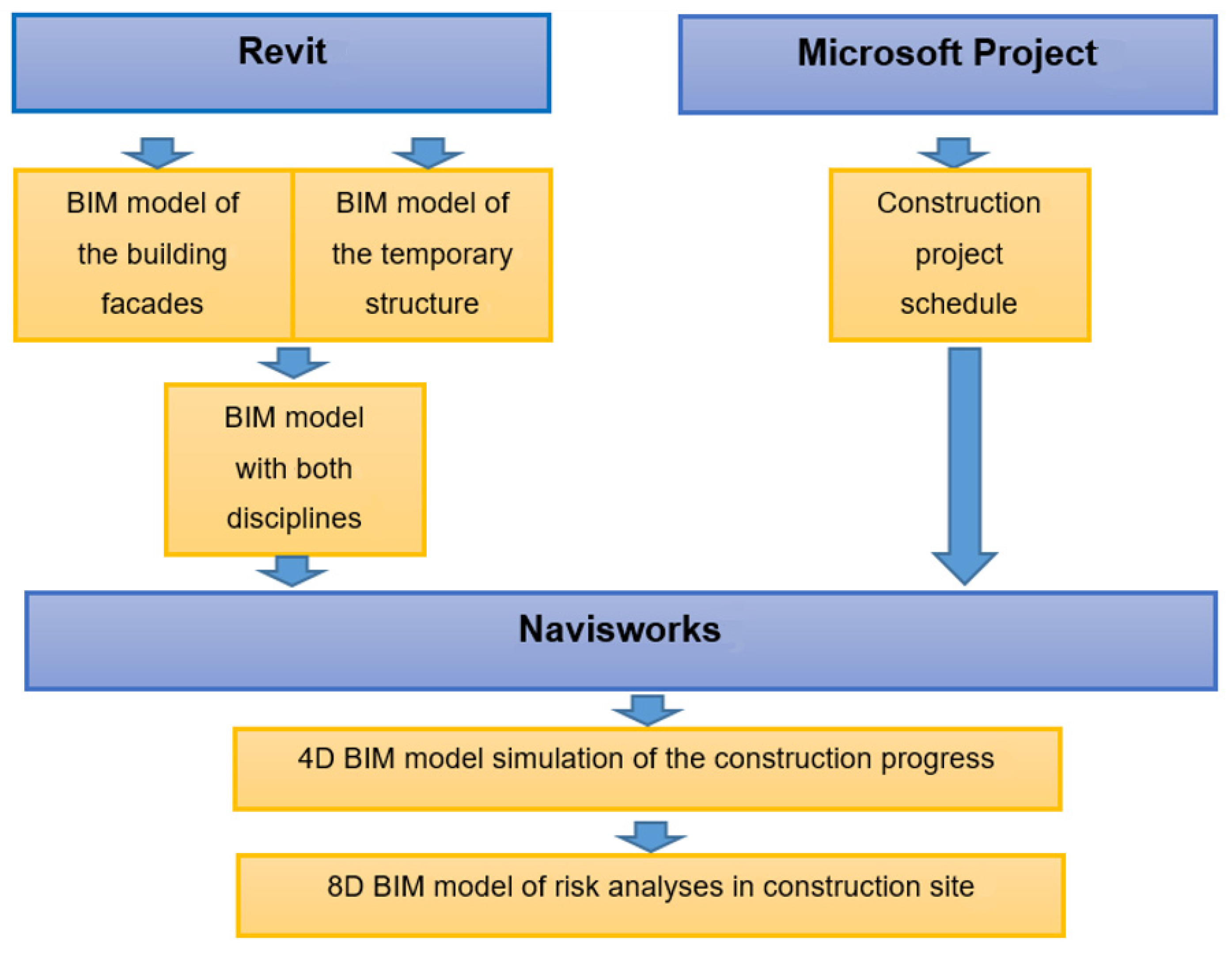
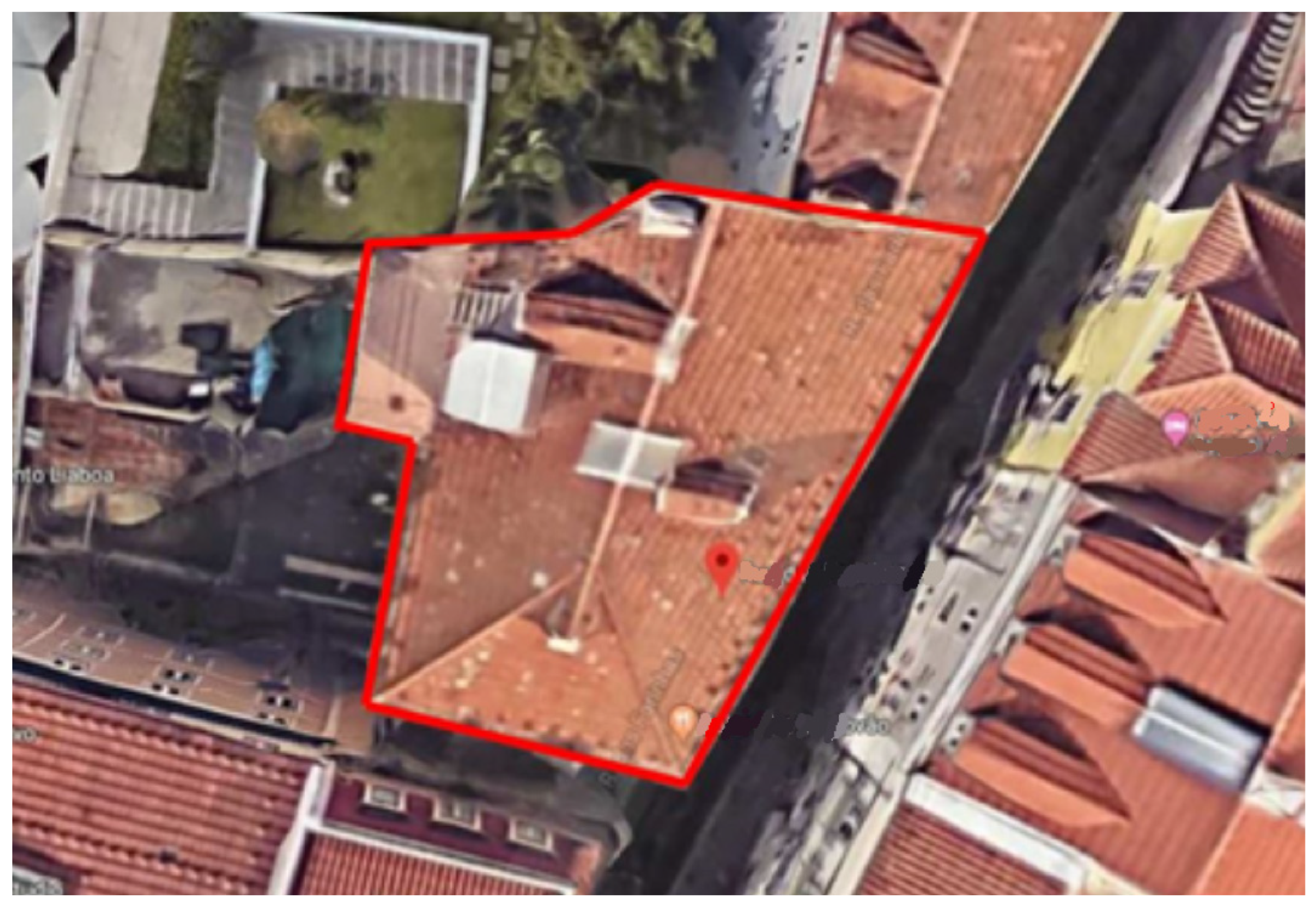
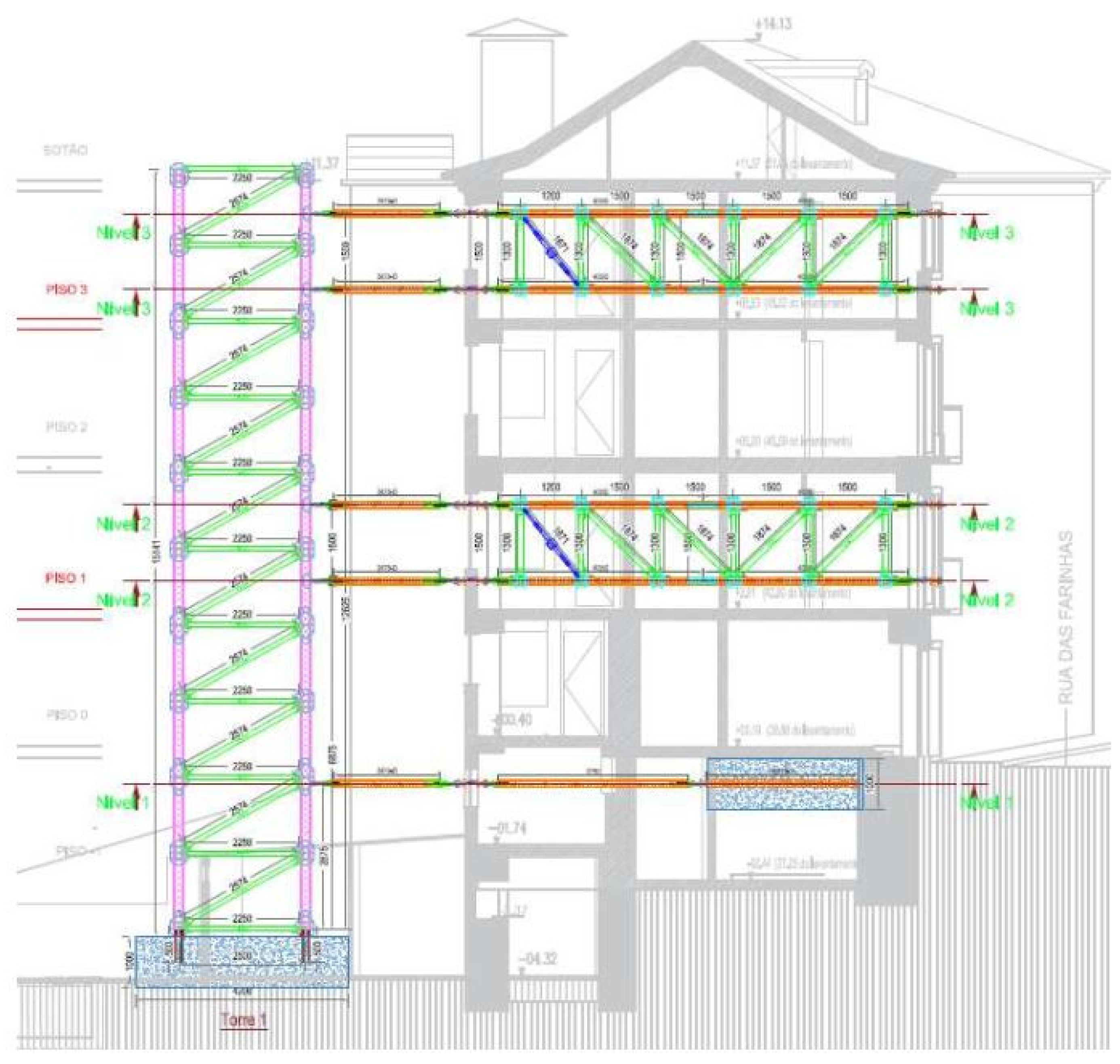
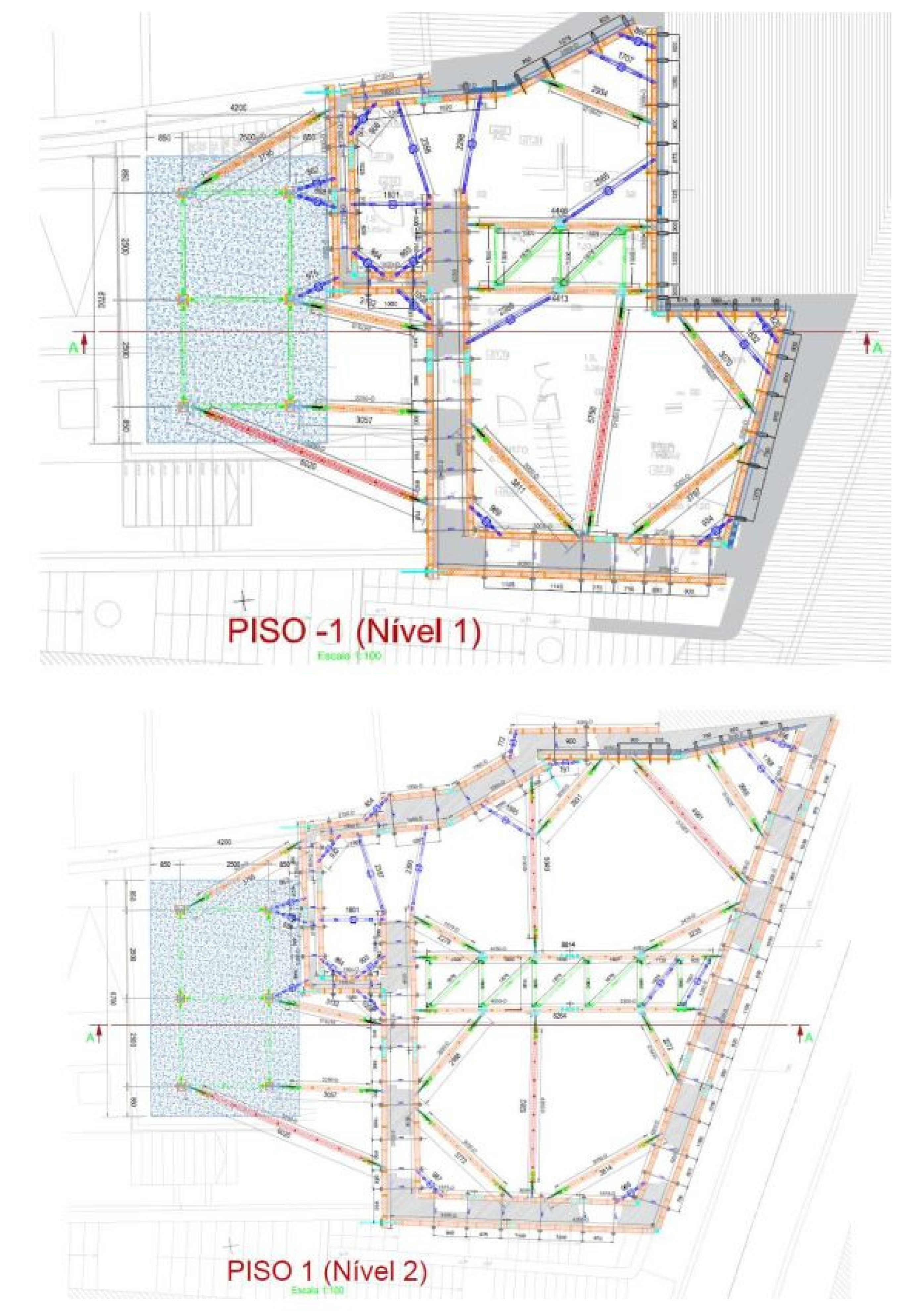
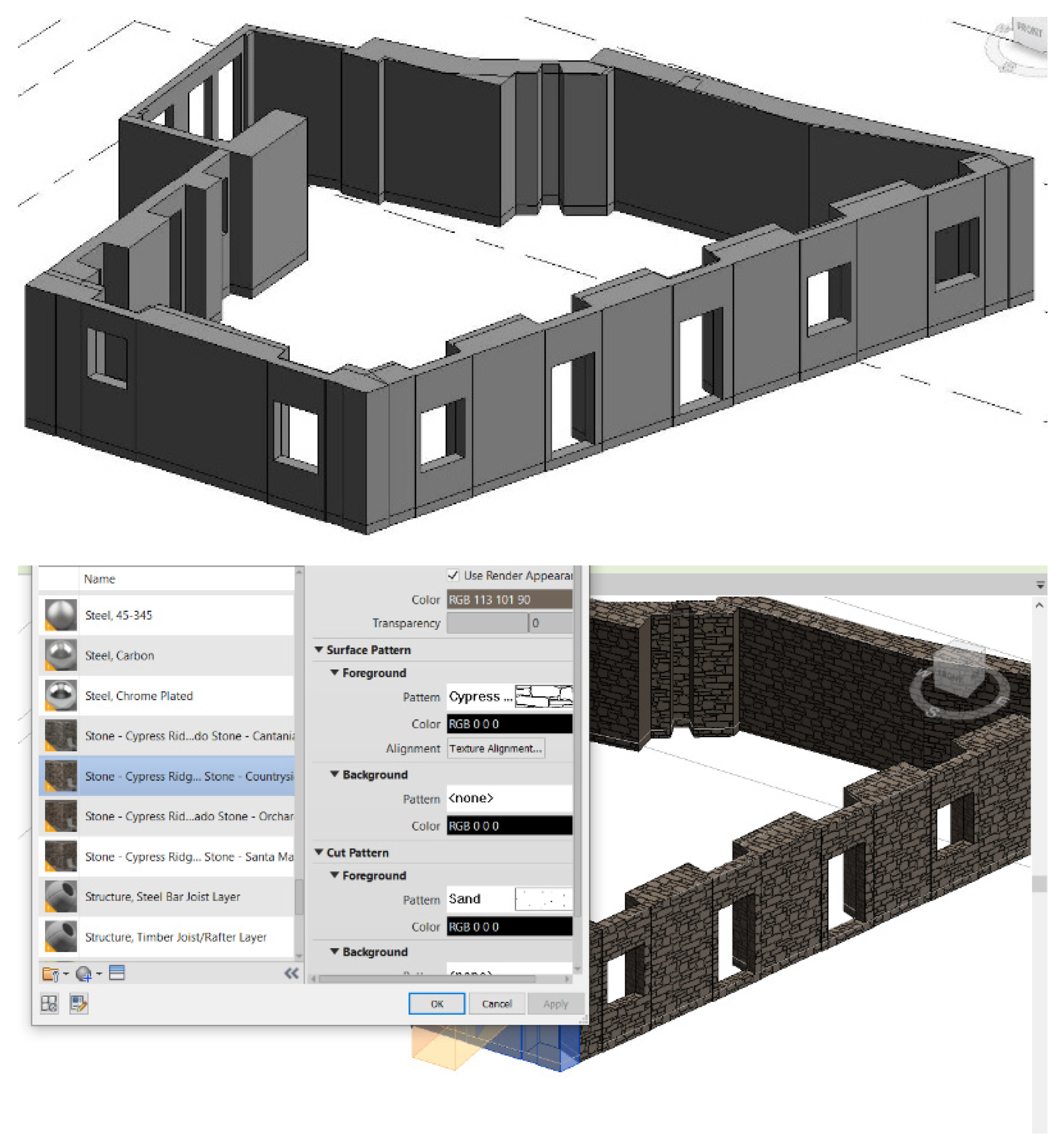
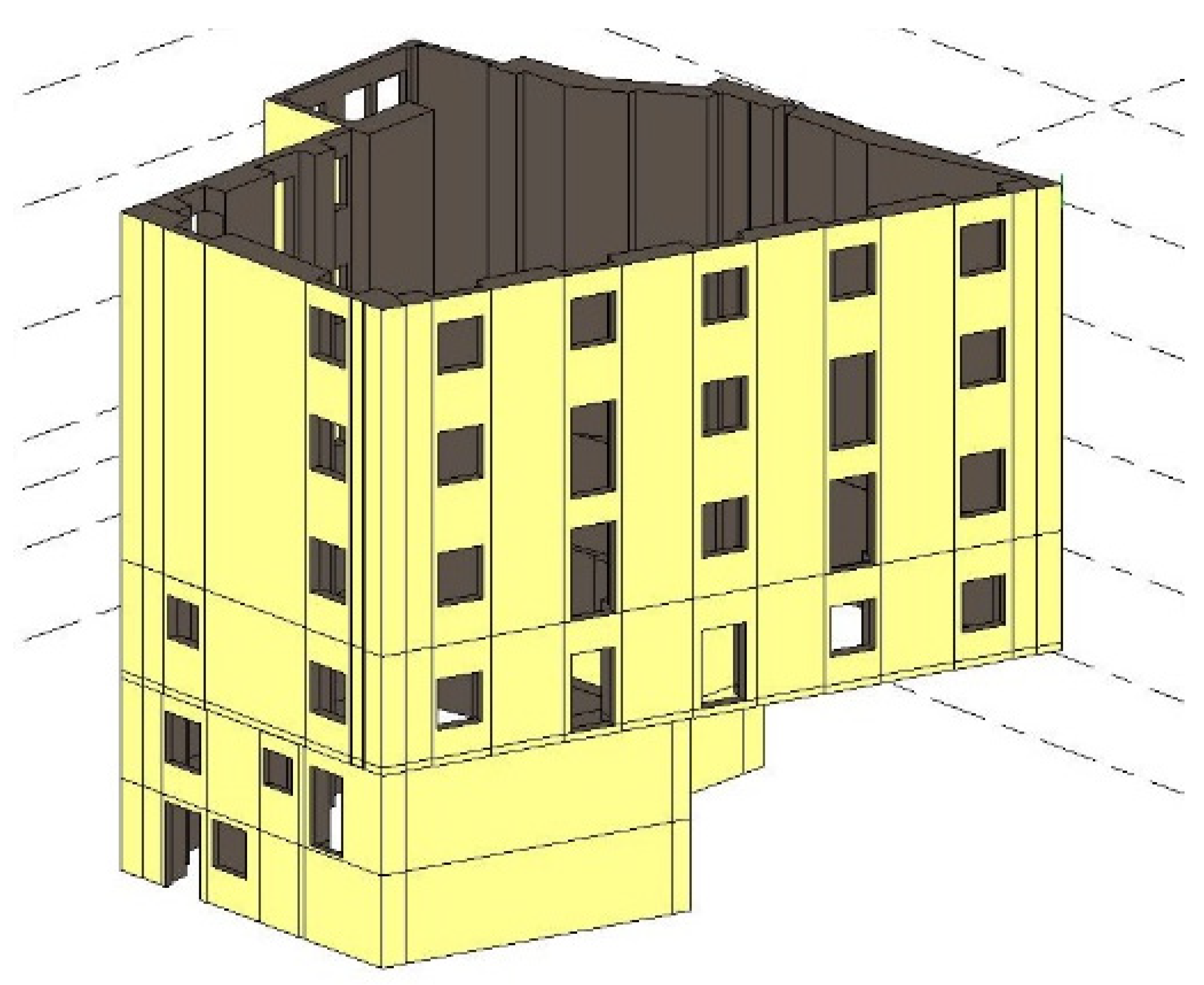

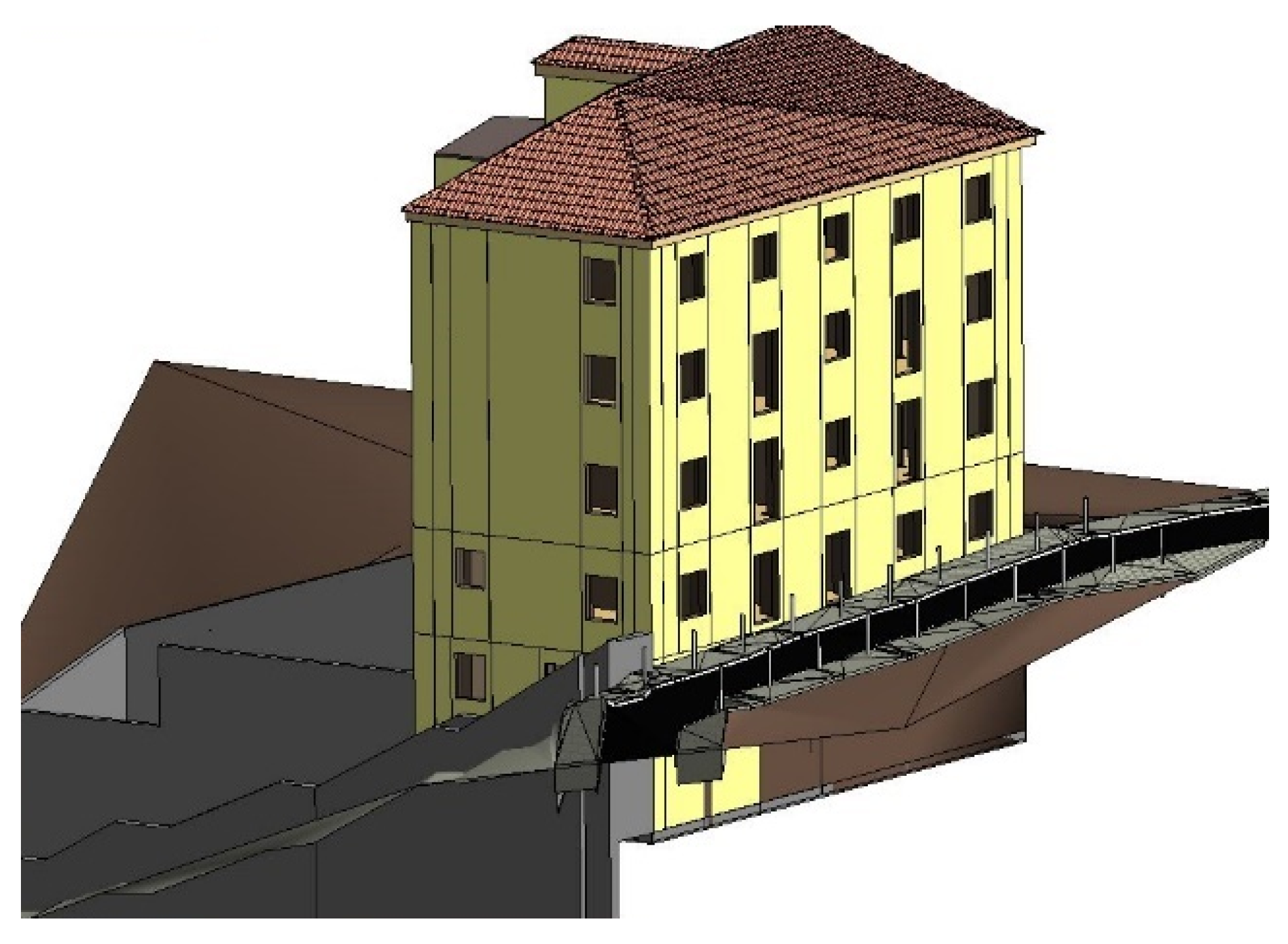



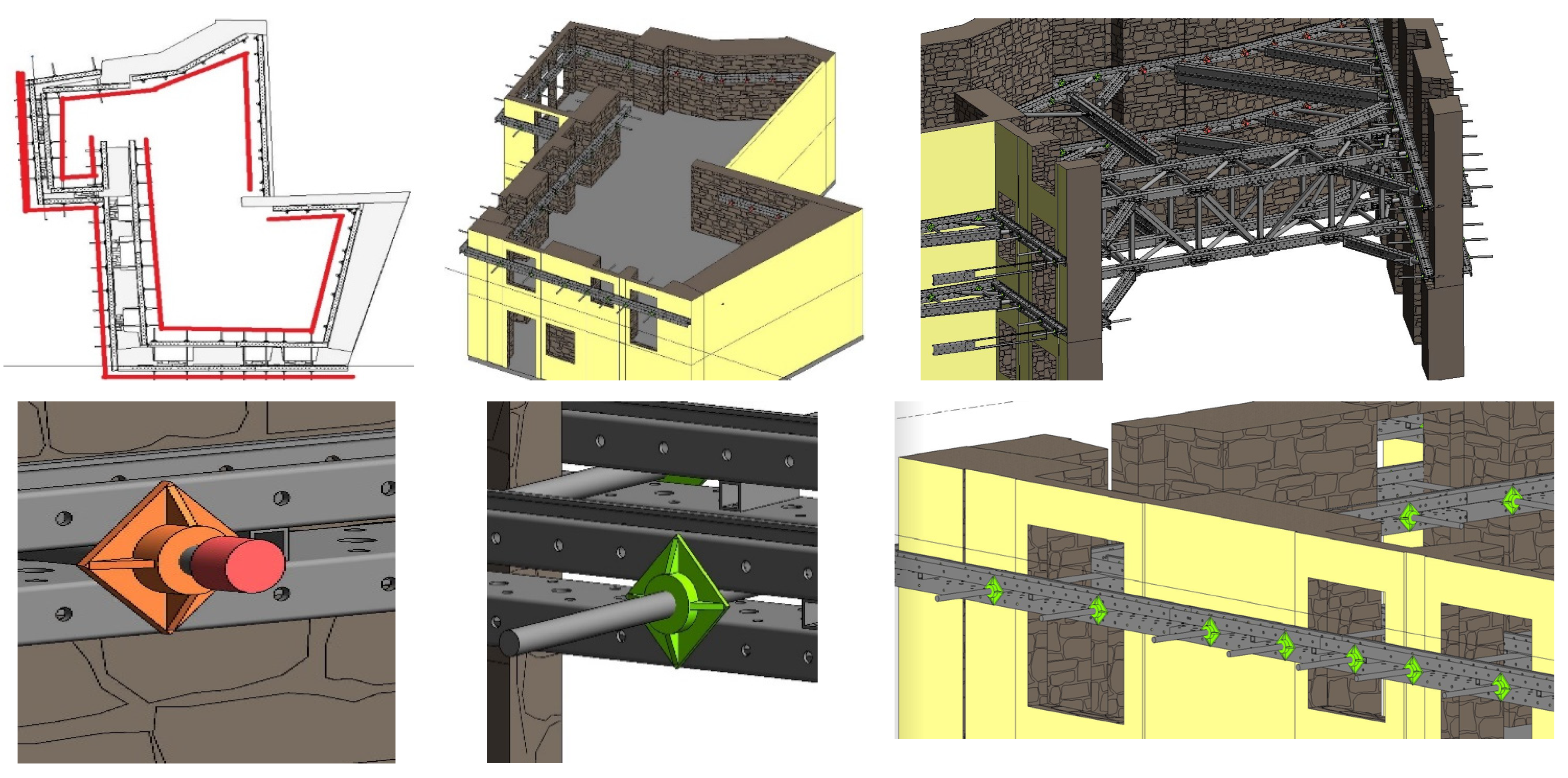

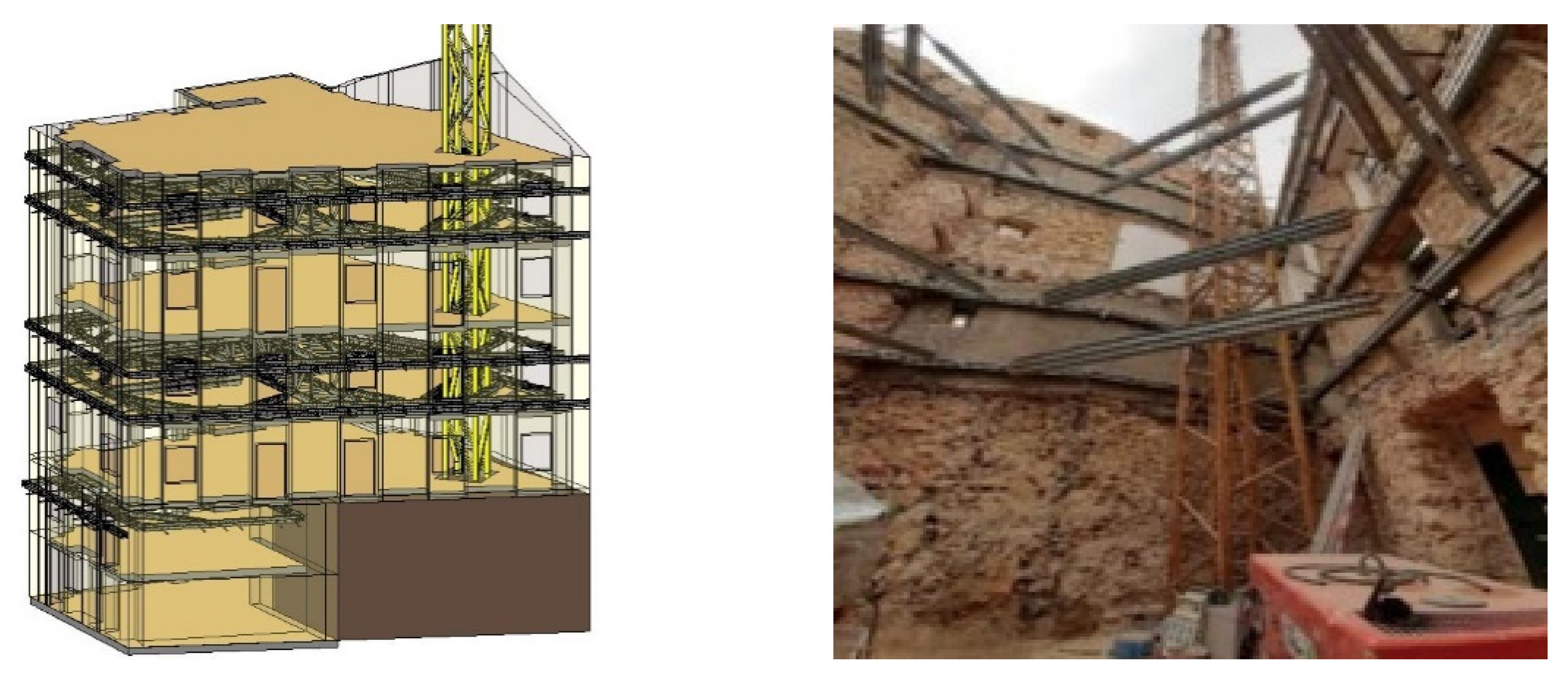
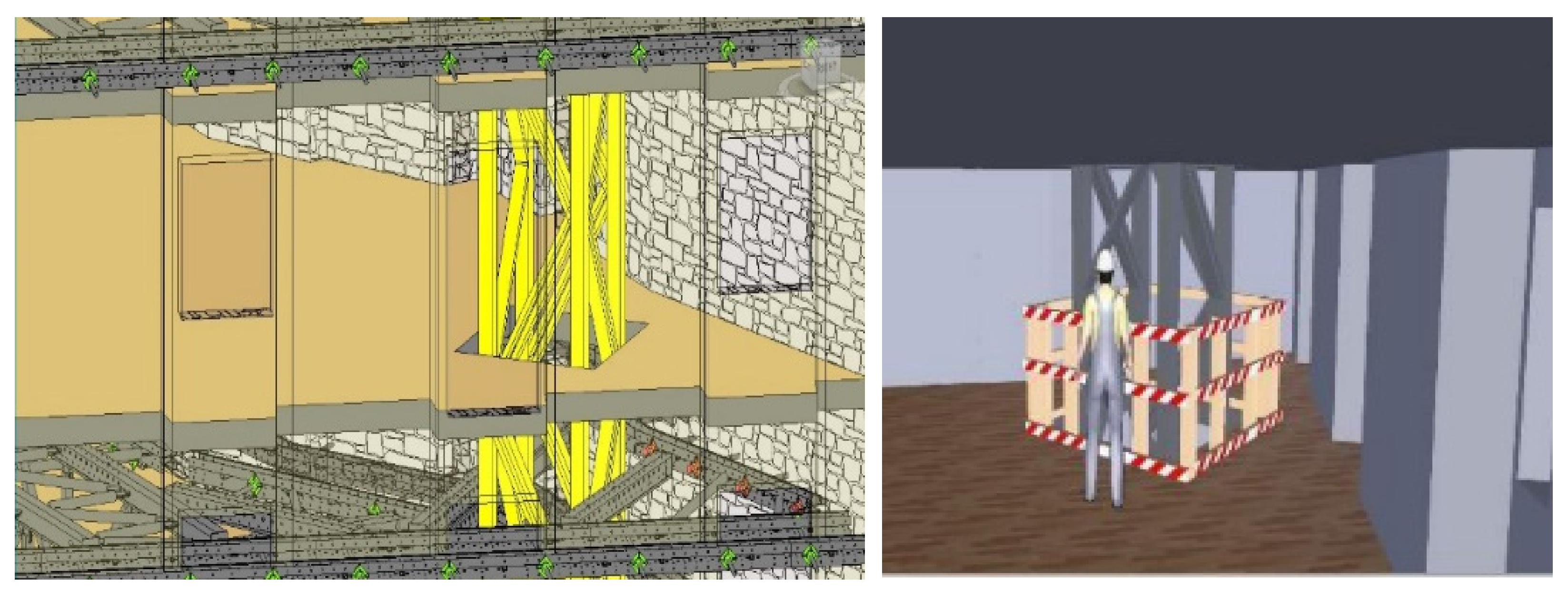
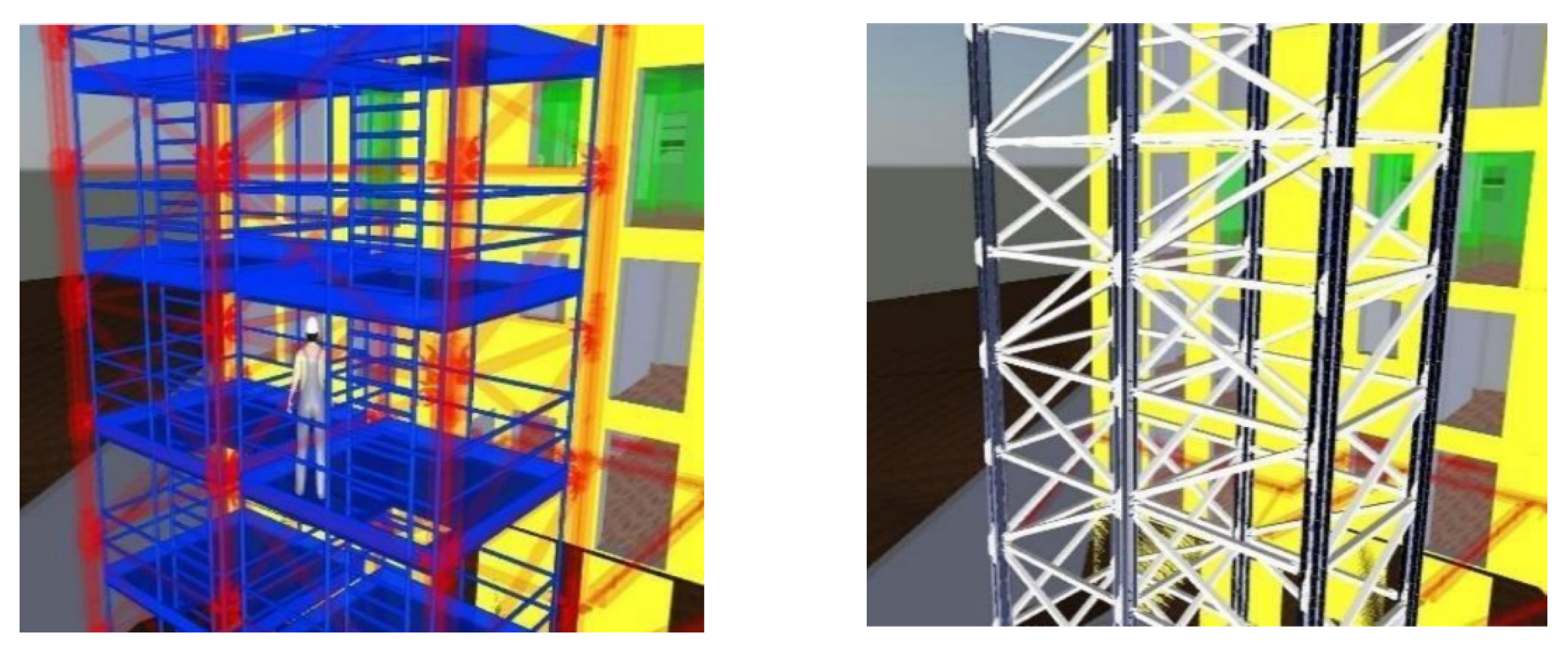




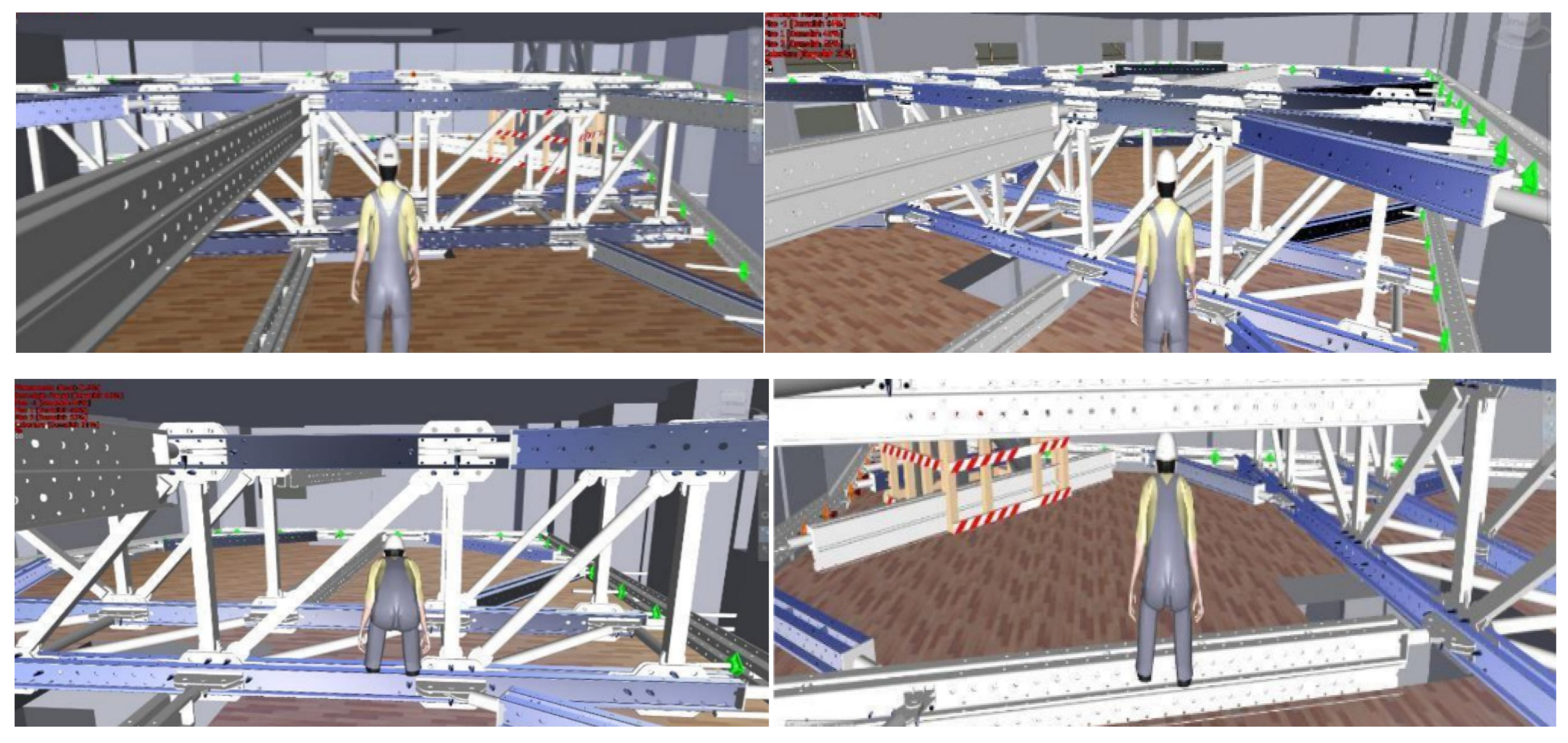
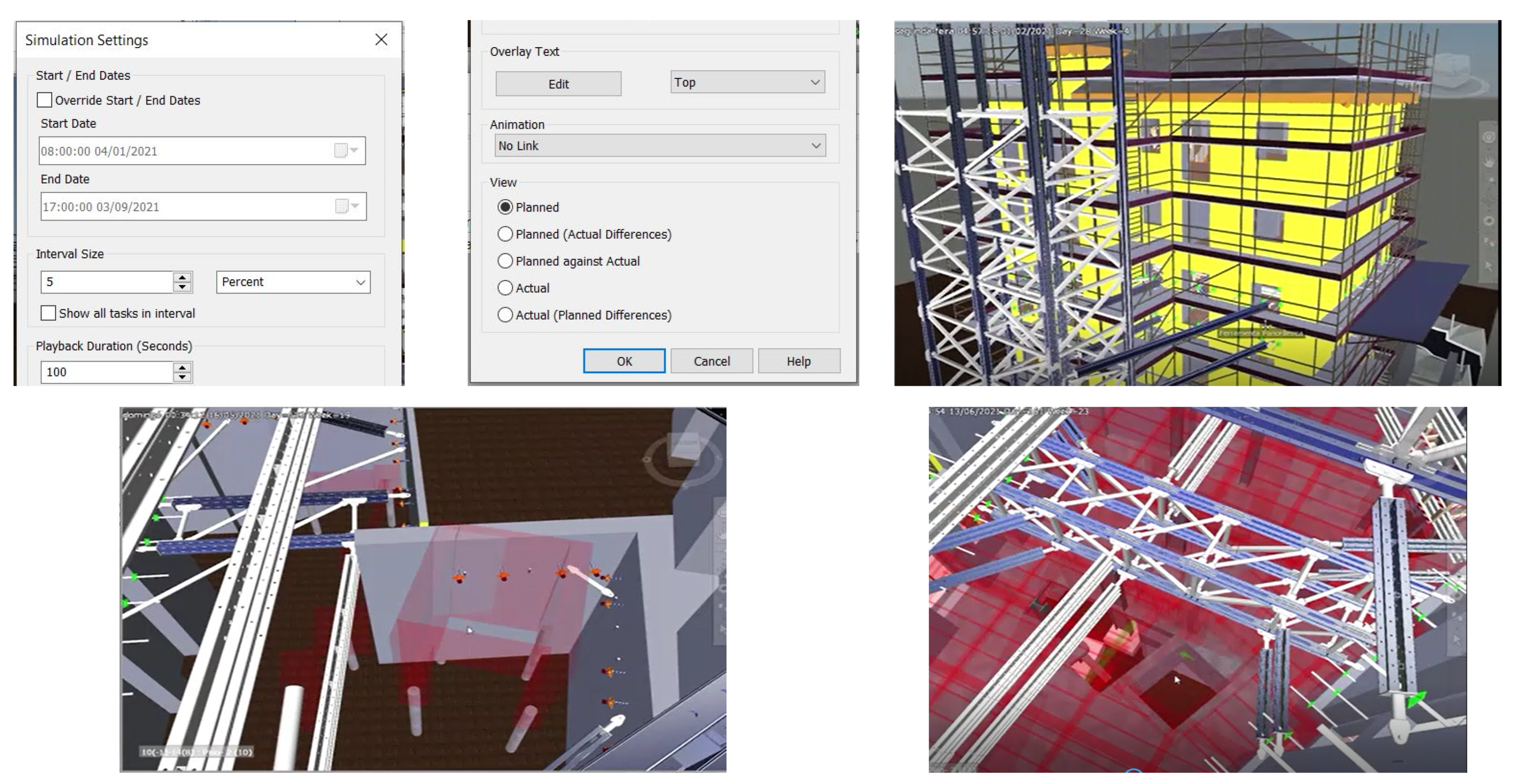

Publisher’s Note: MDPI stays neutral with regard to jurisdictional claims in published maps and institutional affiliations. |
© 2022 by the authors. Licensee MDPI, Basel, Switzerland. This article is an open access article distributed under the terms and conditions of the Creative Commons Attribution (CC BY) license (https://creativecommons.org/licenses/by/4.0/).
Share and Cite
Sampaio, A.Z.; Constantino, G.B.; Almeida, N.M. 8D BIM Model in Urban Rehabilitation Projects: Enhanced Occupational Safety for Temporary Construction Works. Appl. Sci. 2022, 12, 10577. https://doi.org/10.3390/app122010577
Sampaio AZ, Constantino GB, Almeida NM. 8D BIM Model in Urban Rehabilitation Projects: Enhanced Occupational Safety for Temporary Construction Works. Applied Sciences. 2022; 12(20):10577. https://doi.org/10.3390/app122010577
Chicago/Turabian StyleSampaio, Alcínia Zita, Gonçalo B. Constantino, and Nuno M. Almeida. 2022. "8D BIM Model in Urban Rehabilitation Projects: Enhanced Occupational Safety for Temporary Construction Works" Applied Sciences 12, no. 20: 10577. https://doi.org/10.3390/app122010577
APA StyleSampaio, A. Z., Constantino, G. B., & Almeida, N. M. (2022). 8D BIM Model in Urban Rehabilitation Projects: Enhanced Occupational Safety for Temporary Construction Works. Applied Sciences, 12(20), 10577. https://doi.org/10.3390/app122010577







